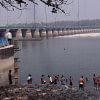Teesta floods bury arable land in sand, leaving farmers devastated

Vast stretches of arable land in 40 unions across 13 upazilas in five northern districts have been buried under sand after recent floods.
According to Department of Agricultural Extension (DAE), these 40 unions across five upazilas in Lalmonirhat, three upazilas in Kurigram, two upazilas in Rangpur, one upazila in Gaibandha, and two upazilas in Nilphamari are part of the Teesta shoal region.
Farmers in the Teesta shoal region, where the land is now unrecognisable, fear that their livelihoods may be lost for years to come, reports our Rangpur correspondent.
As the floodwaters receded, large amounts of sand were revealed—as deep as 2-3 feet in some areas—covering agricultural fields that had been planted with crops, including Aman paddy.
The sand, carried by the floodwaters from the Teesta river, has rendered the land unsuitable for cultivation.
Farmers are in despair, with no means to remove the sand and no clear estimate from the agriculture department on how much land has been affected.
"The crops buried under this sand will not survive. We can't grow anything on this land unless the sand is washed away by future floods," said Nowsher Ali, a farmer from Barogharia village in Lalmonirhat's Aditmari upazila.

His 11 bighas of land have been severely impacted, with three bighas covered in sand.
Like many others, Nowsher is unsure when or if he will be able to use his land for cultivation again.
The problem is widespread across the Teesta shoal. Farmers from Kurigram, Rangpur, Gaibandha, and Nilphamari districts are facing a similar situation.
Every year, during the monsoon floods, significant amounts of sand are washed onto the land, turning fertile fields into barren, uncultivable plots.
Sadekul Islam, a farmer from Gatiashyam village in Kurigram's Rajarhat upazila, said, "One bigha of my land is now covered with sand. Five years ago, two bighas were buried in sand, and I still can't grow anything there."
The potential for recovery depends on nature. If future floods deposit nutrient-rich sediment over the sand, the land could become fertile again. However, farmers say this process can take up to a decade or more.
"If silt comes and covers the sand, we can expect a bumper crop, but it takes years. Right now, it's hopeless," said Dhiren Barman from Gangachara upazila of Rangpur.

Agriculture officials acknowledge the crisis but lack specific data on the extent of the damage.
Abdulah Al Mamun, deputy director of the Department of Agricultural Extension (DAE) in Kurigram said, "We have no official estimate of how much land has been buried under sand this year, but we know it's a recurring issue that affects a large number of farmers. "
A bumper crop is produced when silt is deposited again on land covered by sand, he added.
Rakibul Hasan, executive engineer of the Kurigram Water Development Board said, the problem stems from the accumulation of around 40 lakh metric tons of silt and sand in the Teesta river every year, brought down from upstream areas during floods. This sand then washes onto farmlands along the riverbank.
Rakibul stressed the urgent need to dredge the Teesta river to prevent further damage.
"If the Teesta is dredged, the amount of sand carried by floodwaters will be significantly reduced," he added.
Without immediate intervention, many farmers in the Teesta shoal fear they could lose their livelihoods for years to come, as their once-fertile lands remain buried under layers of sand.

 For all latest news, follow The Daily Star's Google News channel.
For all latest news, follow The Daily Star's Google News channel. 






Comments